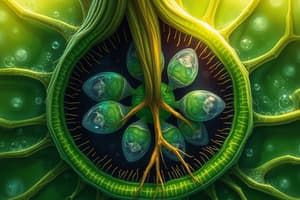Podcast
Questions and Answers
What is the primary function of the palisade layer in plant cells?
What is the primary function of the palisade layer in plant cells?
- To protect the epidermis from water loss
- To transport nutrients through the soil
- To support the structure of the plant
- To absorb sunlight through chloroplasts (correct)
How are root hair cells adapted for water absorption?
How are root hair cells adapted for water absorption?
- They have thick walls for strength
- They contain chloroplasts for photosynthesis
- They have a large surface area (correct)
- They transport nutrients through active transport
What is a key characteristic of xylem cells?
What is a key characteristic of xylem cells?
- They contain large amounts of chlorophyll
- They transport water in one direction only (correct)
- They are alive and contain cytoplasm
- They are responsible for gas exchange
Which feature do guard cells possess?
Which feature do guard cells possess?
What substance strengthens the walls of xylem cells?
What substance strengthens the walls of xylem cells?
Flashcards are hidden until you start studying
Study Notes
Specialised Cells
- Specialised cells are designed to perform specific functions effectively.
- Cell differentiation allows for the development of various cell types with unique structures and roles.
- The waxy cuticle layer protects epidermis cells from water loss and environmental hazards.
- Different cell layers in plants may have varied functions and structures.
- Many plant cells, such as those in roots, do not contain chloroplasts as they are not involved in photosynthesis.
- Guard cells regulate the opening and closing of stomata, controlling gas exchange and water loss.
- Some plants possess enzymes in specialized cells to digest insects for nutrient absorption.
- Palisade mesophyll cells are densely packed with chloroplasts, maximizing sunlight absorption for photosynthesis.
Roots (Root Hair) Cells
- Root hair cells facilitate the absorption of water from the soil via osmosis.
- These cells have an extensive surface area to enhance water and nutrient uptake.
- High numbers of mitochondria within root hair cells provide the energy needed for nutrient transport.
Xylem
- Xylem tissue is responsible for transporting water and dissolved minerals from the roots to the leaves.
- The process of moving water in the xylem is referred to as transpiration.
- Xylem cells lack cytoplasm and nuclei, allowing for unobstructed water flow.
- Comprised of dead cells, xylem transports water in one direction only (upwards).
- There are no walls between xylem cells, facilitating efficient water movement.
- Thickened walls contain lignin, which strengthens xylem structure and supports plant stature.
Studying That Suits You
Use AI to generate personalized quizzes and flashcards to suit your learning preferences.




